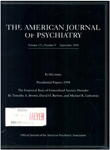Trends in research in two general psychiatric journals in 1969-1990: research on research
Abstract
OBJECTIVE: The authors describe the characteristics of psychiatric research over the past two decades as captured in the articles published by two general psychiatric journals. METHOD: A total of 1,236 articles were drawn from The American Journal of Psychiatry and Archives of General Psychiatry for October through September 1969-1970, 1979-1980, and 1989-1990. Articles were assigned to one of five categories. Research articles were then further categorized as to methodological approach and field of research as well as specific topic areas. Funding sources listed for each research article were also indexed. RESULTS: Over time and in both journals, the percentage and number of research articles have risen, with a concomitant reduction in case reports, opinion papers, and "other" articles. Categories of research design were fairly consistent across time and in both journals. Percentages of articles on specific fields and topics indicated an increasing emphasis on biological studies, especially those in clinical psychobiology, as well as a sharp move away from general categories to a more disorder-specific orientation. Reporting of funding sources has substantially increased. CONCLUSIONS: The large proportion of research articles published in these two important general psychiatric journals reflects editorial policies, changing audience expectations, and the availability of new research tools. Systematic analysis of trends in psychiatric research and other forms of research on research can be useful approaches to assessing the growth and utilization of knowledge in the field, to planning how to most effectively use limited research resources, and to increasing public support for research.
Access content
To read the fulltext, please use one of the options below to sign in or purchase access.- Personal login
- Institutional Login
- Sign in via OpenAthens
- Register for access
-
Please login/register if you wish to pair your device and check access availability.
Not a subscriber?
PsychiatryOnline subscription options offer access to the DSM-5 library, books, journals, CME, and patient resources. This all-in-one virtual library provides psychiatrists and mental health professionals with key resources for diagnosis, treatment, research, and professional development.
Need more help? PsychiatryOnline Customer Service may be reached by emailing [email protected] or by calling 800-368-5777 (in the U.S.) or 703-907-7322 (outside the U.S.).



